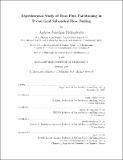| dc.contributor.advisor | Matteo Bucci. | en_US |
| dc.contributor.author | Richenderfer, Andrew Jonathan | en_US |
| dc.contributor.other | Massachusetts Institute of Technology. Department of Nuclear Science and Engineering. | en_US |
| dc.date.accessioned | 2018-11-15T15:51:52Z | |
| dc.date.available | 2018-11-15T15:51:52Z | |
| dc.date.copyright | 2018 | en_US |
| dc.date.issued | 2018 | en_US |
| dc.identifier.uri | http://hdl.handle.net/1721.1/119033 | |
| dc.description | Thesis: Ph. D., Massachusetts Institute of Technology, Department of Nuclear Science and Engineering, 2018. | en_US |
| dc.description | This electronic version was submitted by the student author. The certified thesis is available in the Institute Archives and Special Collections. | en_US |
| dc.description | Cataloged from student-submitted PDF version of thesis. | en_US |
| dc.description | Includes bibliographical references (pages 133-137). | en_US |
| dc.description.abstract | Understanding of subcooled flow boiling and the critical heat flux (CHF) is of the utmost importance for both safety and profitability of pressurized water nuclear reactors since they are major factors in the determination of the reactor power rating. Motivated by the emergence of a new wall boiling model by Gilman [3] and previous experimental insights from Phillips [12], a first-of-a-kind experimental investigation of pressurized steady-state subcooled flow boiling was conducted using state-ofthe- art diagnostics to gain a unique insight of the relevant mechanisms, including the partitioning of the wall heat flux. Conditions up to 10 bar pressure, 2000 kg/m²s mass flux and 20 K subcooling were explored. High-speed infrared thermometry tools were developed and used to measure the local time-dependent 2-D temperature and heat flux distributions on the boiling surface. These distributions were analyzed to determine fundamental boiling heat transfer parameters such as the nucleation site density, growth and wait times, nucleation frequency, departure diameter as well as the partitioning of the wall heat flux. While established mechanistic models can capture the trends of growth time and wait time with relatively good accuracy, this work reveals current models do not accurately predict the activation and interaction of nucleation sites on the boiling surface. This is a major roadblock, since boiling curves and CHF values obtained in nominally identical environments can be significantly different depending upon the nucleation site density which in turn is determined by the surface properties. The role of evaporation in the partitioning of the heat flux increases monotonically as the average heat flux increases, up to a maximum value of 70%, and is the dominant mechanism at high heat fluxes. At low and intermediate heat fluxes single-phase heat transfer is the dominant mechanism. Traditional heat partitioning models fail to capture these physics, but newer models with a comprehensive and physically consistent framework show promise in predicting the wall heat transfer. The data and understanding produced by this work will be essential for the development and validation of these modeling tools. | en_US |
| dc.description.statementofresponsibility | by Andrew Jonathan Richenderfer. | en_US |
| dc.format.extent | 182 pages | en_US |
| dc.language.iso | eng | en_US |
| dc.publisher | Massachusetts Institute of Technology | en_US |
| dc.rights | MIT theses are protected by copyright. They may be viewed, downloaded, or printed from this source but further reproduction or distribution in any format is prohibited without written permission. | en_US |
| dc.rights.uri | http://dspace.mit.edu/handle/1721.1/7582 | en_US |
| dc.subject | Nuclear Science and Engineering. | en_US |
| dc.title | Experimental study of heat flux partitioning in pressurized subcooled flow boiling | en_US |
| dc.type | Thesis | en_US |
| dc.description.degree | Ph. D. | en_US |
| dc.contributor.department | Massachusetts Institute of Technology. Department of Nuclear Science and Engineering | |
| dc.identifier.oclc | 1059513397 | en_US |
